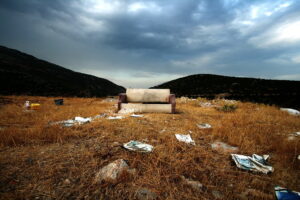Climate chaos gardening: Embracing regenerative practices and protective design
New modelling, products and methods are bringing domestic gardens to the frontline of the environmental emergency. Here’s now.

Heatwaves, thunderstorms, flooding, and – most recently – wild fluctuations in temperature have already marked 2023 out as the latest in a string of summers defined by unpredictable weather. And the mantra seems to be we need to get used to this, because the trend will only continue.
These climate patterns can wreak havoc on infrastructure, transportation and homes. But they are also taking their toll on the natural world, testing its resilience and ability to bounce back. Over time, though, the long-term damage mounts and phenomena like habitat collapse start to rear their head. For the most part, at least, images of this have been on a macro level, but a new report has been published on what the future of Britain’s gardens may look like under sustainable barrage from the elements.
According to landscaping giant, Marshalls, there are a number of priorities that need to be addressed. These include creating flood protection levels, placing potted plants on higher ground, and shading raised flower beds to provide a respite from an increasingly powerful sun. Using AI imagery, the company was able to illustrate the impact of extreme rain, wind and heat on horticulture in a country with a long-standing passionate relationship with gardening.

Evidently, they’re not the only ones thinking in this way. B&Q launched MamaTerra by Verve in June, which it claims brings ‘regenerative farming to the nations’. Essentially, it’s a line of natural garden feeds and pesticides, all sourced from nature and free from synthetic chemicals, helping protect soil and preserve its carbon content. Products range from tomato plant feed to a universal seaweed plant booster and peat-free fruit and vegetable soil improver.
Elsewhere, the rising trend in so-called Chaos Gardening is also a clear sign of the times. Seen by millions at the RHS Chelsea Flower show, the process embraces biodiversity, with gardeners throwing plans out the window to approach planting with abandon. Using combinations of spare seeds, with fruit, vegetable and flowers mixed together, when successful the results require less pruning and maintenance than traditional methods, and provide a more natural source of food for wildlife than carefully allocated allotments.
There are, of course, drawbacks to this. Firstly, those looking for a neat English Garden outside their home will come up very short. More importantly, though, you’ll need to keep a close eye on how things are doing because there is an increased chance of different species competing for nutrients. As such, best advice is to adjust what’s going onto the plants and flowers accordingly.
Of course, just like the climate crisis itself, there are several factors contributing to the birth of Chaos Gardening. One of which is undoubtedly heightened awareness at shared responsibility for improving biodiversity at a local, community level. When you consider than seven-in-eight UK households has access to a garden, it starts to become clear how significant these small steps could be in supporting the country’s declining wildlife. Not least in terms of pollinators such as bees.
More on gardening and the environment:
Using peat in UK horticulture has a devastating climate impact
Biodiversity monitoring is possible, just look at air quality
Images: Marshalls















